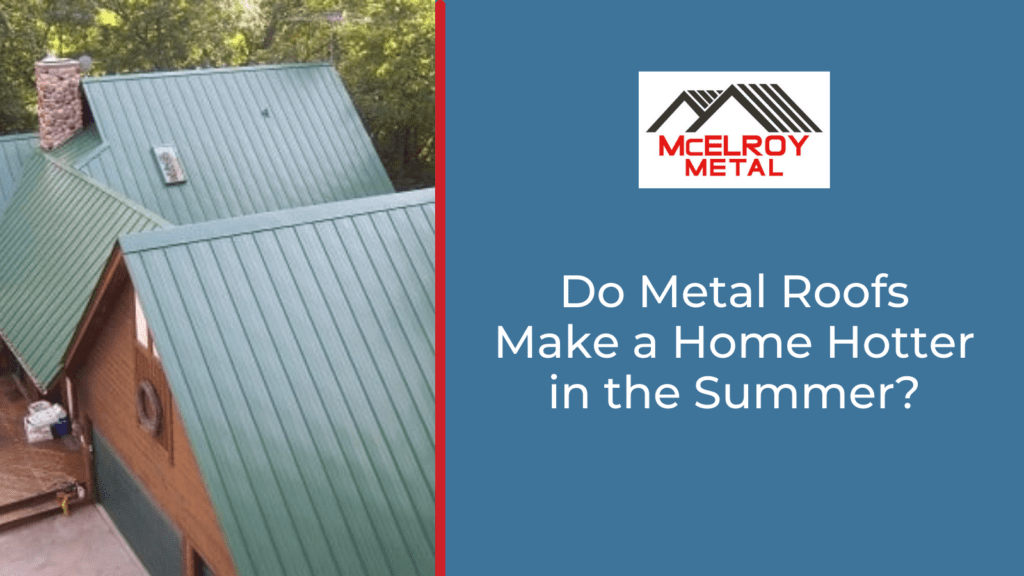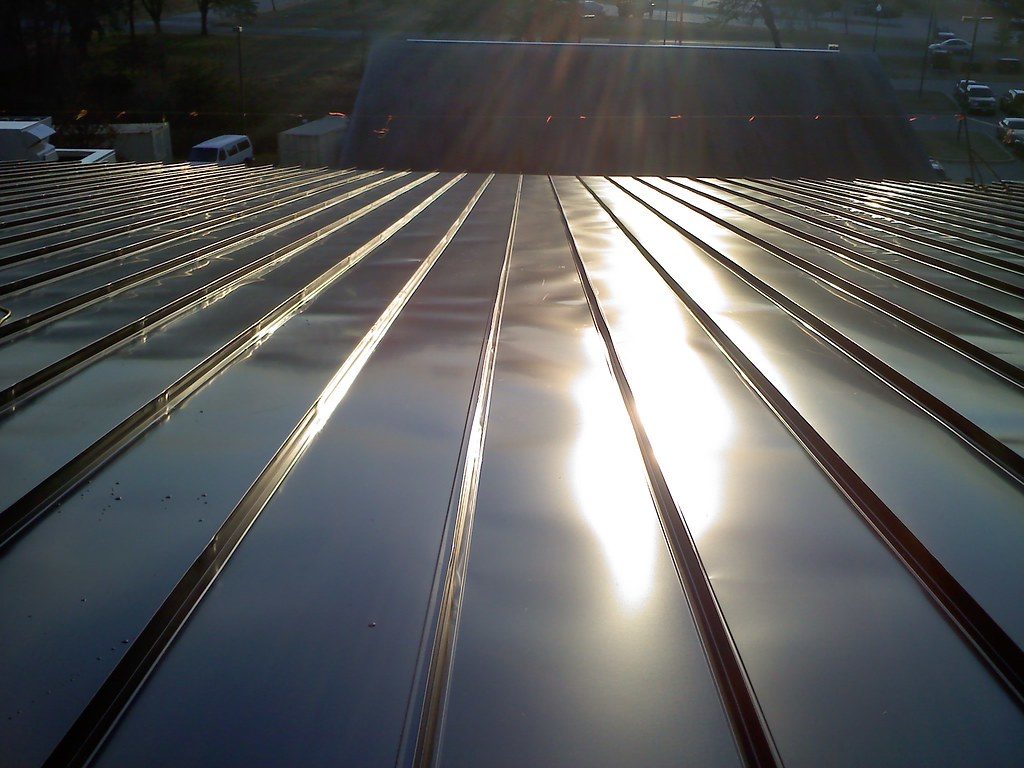If you’ve ever pondered whether metal roofs become hotter than their shingle counterparts, you’re not alone. With the rising popularity of metal roofs, it’s only natural to wonder if they absorb and retain more heat. Well, the answer might surprise you. In this article, we’ll shed light on the age-old question of whether metal roofs get hotter than shingles and provide some insights that might help you make an informed choice for your home. So, let’s put this burning question to rest once and for all!
Benefits of Metal Roofs
Durability
When it comes to durability, metal roofs have a clear advantage. Unlike shingle roofs that can easily get damaged by extreme weather conditions, such as strong winds or hail, metal roofs are built to last. They are highly resistant to impact, making them an excellent choice for homeowners looking for long-term protection for their homes.
Longevity
Metal roofs also have an impressive lifespan compared to shingle roofs. While shingle roofs typically need to be replaced every 20-30 years, metal roofs can last 50 years or more with proper maintenance. This means that once you invest in a metal roof, you can enjoy its benefits for decades to come without having to worry about frequent replacements.
Energy Efficiency
Another significant benefit of metal roofs is their energy efficiency. Metal roofs have high reflectivity, which means they can effectively reflect the sun’s rays and prevent excessive heat from entering your home. This can significantly reduce your cooling costs during those hot summer months. Additionally, metal roofs often have a coating that helps to further enhance their energy efficiency by reducing heat transfer.
Benefits of Shingle Roofs
Affordability
If you’re on a tight budget, shingle roofs can be a more affordable option compared to metal roofs. The cost of shingle roofs is generally lower, and they are widely available in the market. This makes them a popular choice for homeowners looking for a cost-effective roofing solution.
Variety of Styles
Shingle roofs offer a wide range of styles and designs, allowing you to choose the one that best suits your home’s aesthetic. Whether you prefer a traditional look or a more modern and sleek appearance, shingle roofs come in various colors, textures, and patterns, providing you with plenty of options to enhance the curb appeal of your home.
Ease of Installation
Installing shingle roofs is relatively straightforward and does not require specialized skills or equipment. This means that the installation process is generally quicker, which can save you time and reduce the disruption to your daily routine. Furthermore, shingle roofs can be easily repaired or replaced if a section gets damaged, making maintenance more manageable.

Factors Affecting Roof Temperature
Color
The color of your roof plays a significant role in the amount of heat it absorbs. Darker colors, such as black or dark brown, tend to absorb more heat from the sun, leading to higher roof temperatures. On the other hand, lighter colors, such as white or light gray, reflect more sunlight, helping to keep the roof cooler.
Roofing Material
Different roofing materials have varying heat absorption and retention characteristics. Metal roofs, for example, have high reflectivity, which allows them to reflect a significant portion of the sun’s rays and minimize heat absorption. In contrast, shingle roofs, especially those with darker colors, tend to absorb more heat, leading to higher roof temperatures.
Insulation
Insulation plays a crucial role in regulating roof temperature. Proper insulation helps to prevent heat transfer, keeping the heat outside during hot weather and keeping the warmth inside during cold weather. Well-insulated roofs can significantly reduce the temperature differences between your living space and the outdoors, providing greater comfort and energy efficiency.
Color Impact on Roof Temperature
Absorption of Sunlight
The color of your roof can affect the amount of sunlight it absorbs. Dark-colored roofs absorb more sunlight, resulting in higher roof temperatures. This can lead to increased heat transfer to the inside of your home, causing higher cooling costs. Light-colored roofs, on the other hand, reflect more sunlight, reducing heat absorption and keeping your home cooler.
Reflectivity
The reflectivity of a roof determines how much solar radiation it reflects. Roofs with high reflectivity can reflect a significant portion of the sun’s rays, reducing heat absorption and keeping the roof cooler. Metal roofs are known for their high reflectivity, making them an excellent choice for homeowners looking to minimize heat transfer.

Effect of Roofing Material on Temperature
Thermal Conductivity
Thermal conductivity is a measure of a material’s ability to conduct heat. Metal roofs have low thermal conductivity, meaning they are not as efficient at transferring heat. As a result, metal roofs tend to retain less heat, keeping the roof temperature lower than other roofing materials.
Heat Capacity
The heat capacity of a roof refers to its ability to absorb and store heat. Metal roofs have a lower heat capacity compared to shingle roofs, meaning they can cool down faster once the sun goes down. This can help to prevent heat from radiating into the home during the evening hours, leading to lower energy usage and increased comfort.
Insulation’s Role in Roof Temperature
Types of Insulation
There are various types of insulation that can be used to regulate roof temperature. Common insulation materials include fiberglass, cellulose, and foam. These materials help to trap air and create a barrier that prevents heat transfer. The type of insulation you choose can greatly influence the thermal performance of your roof.
Insulation Thickness
The thickness of insulation also plays a crucial role in controlling roof temperature. Thicker insulation provides better resistance to heat transfer, resulting in lower roof temperatures. By ensuring adequate insulation thickness, you can create a more comfortable living environment and reduce your energy consumption.

Metal Roofing and Heat Retention
Reflectivity of Metal Roofs
As mentioned earlier, metal roofs have high reflectivity, which allows them to reflect a significant amount of solar radiation. This helps to minimize heat absorption and keep the roof temperature lower compared to other roofing materials. With a metal roof, you can enjoy a cooler home and potentially reduce your cooling costs.
Insulation Under Metal Roofs
While metal roofs already have inherent heat-regulating properties, adding insulation underneath can provide even greater energy efficiency. Insulation helps to further reduce heat transfer, keeping the interior of your home cooler in hot weather. Additionally, insulation can also improve soundproofing and reduce outside noise.
Ventilation in Metal Roofs
Proper ventilation is crucial for metal roofs, as it helps to expel hot air that may build up in the attic space. Ventilation systems, such as ridge vents or soffit vents, allow for air circulation, preventing heat from getting trapped inside the roof. This can help to maintain lower roof temperatures and enhance the overall energy efficiency of your home.
Shingle Roofing and Heat Retention
Absorption of Heat by Shingles
Shingle roofs, especially those with darker colors, tend to absorb a significant amount of heat from the sun. This can result in higher roof temperatures, which can then radiate into the home. While shingle roofs may not have the same inherent heat-regulating properties as metal roofs, there are ways to mitigate heat retention.
Ventilation in Shingle Roofs
Proper ventilation is essential for shingle roofs to help dissipate heat and maintain lower roof temperatures. Adequate airflow through the attic space can prevent the accumulation of hot air, reducing the transfer of heat into the rest of the house. Ventilation options for shingle roofs include ridge vents, gable vents, and attic fans.

Studies Comparing Metal and Shingle Roofs’ Heat
ASHRAE Study
A study conducted by the American Society of Heating, Refrigerating and Air-Conditioning Engineers (ASHRAE) compared the heat absorption and retention of metal and shingle roofs. The study found that metal roofs had significantly lower roof temperatures compared to shingle roofs, especially when exposed to direct sunlight. This indicated that metal roofs are more effective at minimizing heat transfer into the home.
Florida Solar Energy Center Study
The Florida Solar Energy Center conducted a study that evaluated the heat retention of different roofing materials, including metal and shingle roofs. The study concluded that metal roofs had lower peak roof temperatures and lower heat transfer into the attic compared to shingle roofs. This further supported the energy-saving benefits of metal roofs.
Energy Department Study
The U.S. Department of Energy also conducted a study that compared the energy efficiency of different roofing materials. The study found that metal roofs with high reflectivity significantly reduced cooling costs and improved indoor comfort compared to shingle roofs. The findings emphasized the importance of selecting roofing materials that can effectively regulate heat transfer.
Conclusion
In conclusion, the temperature of a roof is influenced by several factors, including color, roofing material, and insulation. Metal roofs offer numerous benefits, such as durability, longevity, and energy efficiency. Their high reflectivity and insulation properties help to keep roof temperatures lower and reduce cooling costs. On the other hand, shingle roofs are more affordable, offer a variety of styles, and have simpler installation processes. However, shingle roofs tend to absorb more heat and require proper ventilation to minimize heat retention.
Various studies have consistently shown that metal roofs have lower roof temperatures and better heat-regulating capabilities compared to shingle roofs. The ASHRAE study, Florida Solar Energy Center study, and Energy Department study all support the conclusion that metal roofs are more effective at minimizing heat transfer into the home and reducing cooling costs.
When considering different roofing options, it is essential to take into account your climate, budget, and personal preferences. Metal roofs may be more suitable for hotter climates, as they can significantly reduce heat absorption and improve energy efficiency. Shingle roofs, on the other hand, may be a more budget-friendly choice for homeowners looking for a variety of styles and easier installation. By understanding the factors affecting roof temperature and considering your specific needs, you can make an informed decision that maximizes the benefits of your chosen roofing material.
